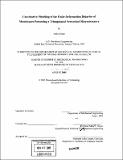Constitutive modeling of the finite deformation behavior of membranes possessing a triangulated networked microstructure
Author(s)
Arslan, Melis
DownloadFull printable version (12.96Mb)
Other Contributors
Massachusetts Institute of Technology. Dept. of Mechanical Engineering.
Advisor
Mary C. Boyce.
Terms of use
Metadata
Show full item recordAbstract
Many biological, natural and synthetic materials possess a networked or micro-truss-like microstructure. In this thesis work, a general microstructurally-informed continuum level constitutive model of the large stretch behavior of membranes possessing a triangulated network or truss-like structure is developed. As a specific example, a constitutive model of the stress-strain behavior of the red blood cell membrane is developed. The mechanical behavior of the membrane of the red blood cell is governed by two primary microstructural features: the lipid bilayer and the underlying spectrin network. The lipid bilayer is analogous to a 2D fluid in that it resists changes to its planar area, yet poses little resistance to planar shear. A skeletal network of spectrin molecules is crosslinked to the lipid bilayer and provides the shear stiffness of the membrane. The planar triangulated structure of the spectrin network is used to identify a representative volume element (RVE) for the model. A strain energy density function in terms of an arbitrary planar deformation field is proposed using the RVE. Differentiation of the strain energy density function provides expressions for the general multiaxial stress-stretch behavior of the material. (cont.) The stress-strain behavior of the membrane when subjected to uniaxial and simple shear loading conditions in different directions is given, showing the capabilities of the proposed microstructurally-detailed constitutive modeling approach in capturing the evolving anisotropic nature of the mechanical behavior. The proposed constitutive model also provides a framework to explore the contributions of mechanically-induced unfolding. The force-extension behavior of a single modular macromolecule exhibits a "saw-tooth" pattern due to unfolding giving a sequence of force rise to a peak followed by a load drop. Using the introduced continuum approach together with single molecule force-extension behavior and a transition state model of unfolding, large deformation behavior of two-dimensional networks of biomacromolecules is studied for various loading conditions. The effect of the strain-rate on the mechanical response is investigated.
Description
Thesis (S.M.)--Massachusetts Institute of Technology, Dept. of Mechanical Engineering, 2005. Includes bibliographical references (p. 108-114).
Date issued
2005Department
Massachusetts Institute of Technology. Department of Mechanical EngineeringPublisher
Massachusetts Institute of Technology
Keywords
Mechanical Engineering.